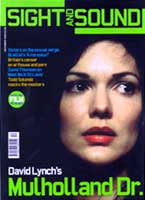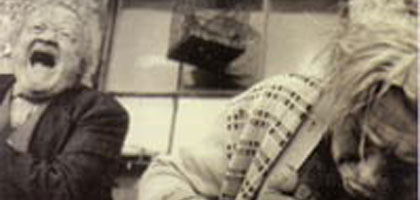
This Filthy Earth
UK 2001

Reviewed by Peter Matthews
Synopsis
Our synopses give away the plot in full, including surprise twists.
The North of England, anytime. Francine (Rebecca Palmer) and Kath (Demelza Randall) are sisters living on the farm of their dead parents with Kath's baby daughter Etta (Etta Kötting). Kath will inherit the land when she turns 21, a fact not lost on Etta's father Buto (Shane Attwooll), who proposes marriage. Francine tries to convince her sister of Buto's selfish motives, but the wedding goes ahead and he moves in with them. One day Lek (Xavier Tchili), a foreign-born labourer, arrives at the farm to return Francine's straying cow Ivy. Buto orders him off the property, but Francine is intrigued by his gentle demeanour. At harvest time, Buto and the sisters scythe the wheat by hand, while Lek uses a threshing machine. When Lek catches Francine napping in the sun, she sends him away in confusion. Megan (Eve Steele), an outcast who lives in the woods with her blind brother Joey (Ryan Kelly), hopes to earn a pittance by sharing in the toil. Driven on by Buto, she dies from exhaustion. Armandine (Ina Clough), the sisters' meddling aunt, accuses Lek of killing her by supernatural means. Francine is left to drag Megan's body away. Lek offers help, but Francine rejects him.
It begins to rain heavily, and the harvest is lost. Armandine blames Lek, inciting the villagers to superstitious fury against him. The only one who speaks up for Lek is Buto's drunken brother Terence (Peter-Hugo Daly), known as Jesus Christ. Lek attempts to confront Armandine in the house she shares with her brother (Dudley Sutton), who is known as Papa and who is the father of Buto and Jesus Christ. But the villagers ambush Lek and tie him to a wheel. Meanwhile, Francine refuses to budge from the stable because Ivy is about to calve. Buto tries to evict Francine and ends up raping her. Joey releases Lek, who squares off with Armandine. She is slowly engulfed by the mud. Ivy dies in labour, and the calf is stillborn. Grief-stricken, Francine attacks Buto, who locks her in the barn. Lek rescues Francine, then wrestles with Buto. Joey leaps from the stable roof and lands on Buto, killing him. Lek asks Francine to leave the village with him, but she says that life there is all she has. The next day, it stops raining. Lek and Joey depart the village together.
Review
On the evidence of This Filthy Earth, director Andrew Kötting is no storyteller, but the film exhibits so bold and singular a talent that it hardly matters. His earlier feature, the wonderfully picaresque documentary Gallivant (1996), achieved a loose spatial unity through its premise - Kötting, his daughter and grandmother tour the British coastline clockwise in a camper van. For his first stab at full-length fiction, however, he has chosen to adapt Emile Zola's 1887 La Terre, a chunky 19th-century novel full of outsized characters and thumping melodrama. Kötting might look about as suited to the material as Terence Davies would be if he took a crack at Basic Instinct. Still, by conceding his defective narrative sense, Davies turned the moody, elliptical 2000 version of Edith Wharton's The House of Mirth into a peculiar triumph. Kötting is even more radical in dismantling Zola, and anyone deluded enough to expect a plush heritage film along the lines of Claude Berri's 1993 Germinal will probably go into toxic shock. This Filthy Earth is a true phantasmagoria inhabited by rural monsters and grotesques so backward they seem prehistoric. It's virtually impossible to find one's bearings in this floating nightmare. Kötting chips away at our ordinary filmgoing security with a screechingly abrasive technique that combines slow and speeded-up motion, time-lapse photography, changes in film stock, non-synchronous sound and archival inserts. At times, the fractured imagery produces a near-subliminal effect - was it a hallucination or did we really see an old crone sinking beneath the surface of the primal slime?
Only in the latter half does a semi-decipherable plot materialise. Yet the film is most powerfully visionary at its least coherent. There's a notable thinning in intensity once events begin to develop a logic, for Kötting is neither skilled at nor remotely engaged by conventional dramatic motives that slap a straitjacket on his wild poetic imagination. In the penultimate sequence, for instance, the heroine Francine opts to stay in the village where she has been so wretched - an attempt at closure that seems weak and plain idiotic because the director has done practically nothing to establish her as a character with a plausible inner life. Literary source (and secondary inspiration from John Berger's account of peasant hardship Pig Earth) notwithstanding, the story feels like a compromise intended to make the project marginally viable in commercial terms. One has the impression that left to his own devices, Kötting would leap off the deep end into complete pandemonium - even as it stands, the picture owes more to the proto-surrealist fancies of Bosch and Bruegel than the pseudo-scientific pretensions of Zola. Though the setting has been vaguely Anglicised to Yorkshire, anthropological accuracy is far from the point. Intoning the most preposterous soothsaying dialogue, sporting threadbare costumes that belong to no particular time or place, these country people suggest the immemorial archetypes of a folk tale.
Sensation-monger that he was, Zola served up a witches' brew of murder, rape, incest and scatology in the name of truth-loving naturalism. Kötting and his co-screenwriter Sean Lock have scrubbed much of the obscene detail, but thanks to cinema's perceptual immediacy, what remains is still awesomely disgusting. In the very first scene, our toiling farm maiden gets drenched in about a gallon of bull's sperm; moments later, her senile uncle abstractedly pricks a blister filled with pus. There are also sufficient shots of shit, blood, rotting carcasses and other species of ordure to justify the title and then some. The screen hasn't beheld this amount of putrid ugliness since the glory days of Erich von Stroheim, yet it would be a mistake to write off Kötting as a gloating misanthrope. What's remarkable about the film (and here it cleaves most faithfully to Zola) is the blunt impartiality of the observation. Repugnant though they might appear in their greed, treachery and crude superstition, the rustics possess an elemental innocence that sets them beyond moral judgement. Kötting views his characters without horror, patronage or even sympathy because they are mere excrescences of nature - troglodytes who have only just deserted their caves and still cling narrowly to the earth. The largely unfamiliar cast disappear into their roles and consummate the archaic illusion. Indeed, one learns with a faint jolt that the loathsome, jabbering crone is played by a professional actor and not a bag lady Kötting picked up somewhere. Despite and through its many exasperations, the movie is an unforgettable experience and heralds the rise of a major British film-maker.
Credits
- Director
- Andrew Kötting
- Producer
- Ben Woolford
- Screenplay
- Andrew Kötting
- Sean Lock
- Inspired by the novel
- La Terre by Emile Zola
- Director of Photography
- N.G. Smith
- Editor
- Cliff West
- Production Designer
- Judith Stanley-Smith
- Music/Music Arranger
- David Burnand
